LLTT Newsletter - June 2025

LLTT - June 2025
Welcome back!
This month we're taking a detour into history — but there's a reason for it. We're going back over 200 years to see how stenographic principles from the past might help us understand the present.
The examples below are not from standard Teeline materials. Teeline does not have rules in the traditional sense, and you don't need to learn these to master modern Teeline.
Samuel Taylor's shorthand system was published in 1786 and used an alphabet of 19 simplified geometric letters. It was written partially phonetically. The system omitted vowels except at the beginning and end of words, where they were written as a single dot, and consonants were joined together like cursive writing. Taylor shorthand was influential and dominant until it was eventually superseded by Pitman, which actually built upon Taylor's foundation. As most of you know, James Hill, the man who invented Teeline, qualified as a teacher of Pitman shorthand by the age of 21.
So why share them at all? Because there can be considerable merit in studying the broader stenographic world, particularly once you've developed a solid grasp of Teeline theory. You never know when an historical insight can expand your thinking about what is possible when you truly understand how language works.
Therefore, this issue is meant for interpretation and reflection, not direct application.
Let's be absolutely clear: these “rules” are not intended to convey “shortcuts” to speed or mastery. Nothing replaces the hard work and dedication that shorthand demands.
The fundamentals of Teeline — proper letter and outline formation, consistent practice, methodical progression through the theory — should remain your focus and no amount of historical perspective can substitute for that essential groundwork.
However, learning about shorthand's past is never a wasted effort. The principles that drove innovation centuries ago might continue to influence how we think about efficient writing today.
Some of these ideas may resonate with your developing understanding of Teeline; others may feel irrelevant to your particular approach. Both responses are perfectly valid.
We are simply presenting something different from the stenographic archives. Thoughts that, despite their age, reveal interesting parallels to the Teeline we know and love today. As always, take what works, leave what doesn't, and remember the best shorthand writers have always been curious students of their craft's broader traditions.
The “rules” presented below are from Samuel Taylor's "A Universal System of Stenography," which was published 218 years ago. This was a book that essentially launched the first standardised shorthand system used across the English-speaking world. His stenographic method consisted in cutting out the superfluous consonants as well as the vowels in polysyllabic words. Vowels were omitted (except at the beginning and end of a word), and the system was economical — a single letter stood for both f and v, one for s and z, and another for g and j, as well as additional letters for ch, sh, th. Those of you who know Teeline well should see some similarities.
While the language in these images is antiquated, let’s see if there are any insights relevant for today's Teeline students.
Rule I
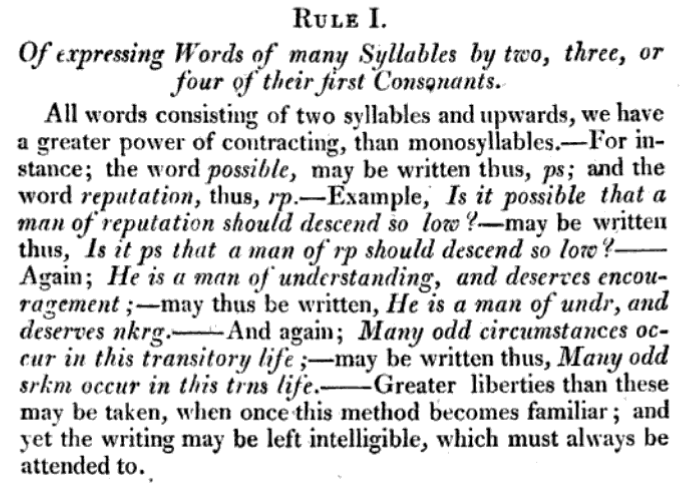
This expresses what Teeline students learn well; once you learn how to skeletonise a word, it retains enough information to still be recognisable. Although Taylor didn’t discuss one syllable words above, when you write 'B' for 'be' or 'R' for 'are,' in Teeline, you're also relying on the power of contracting.
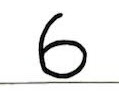
Rule II
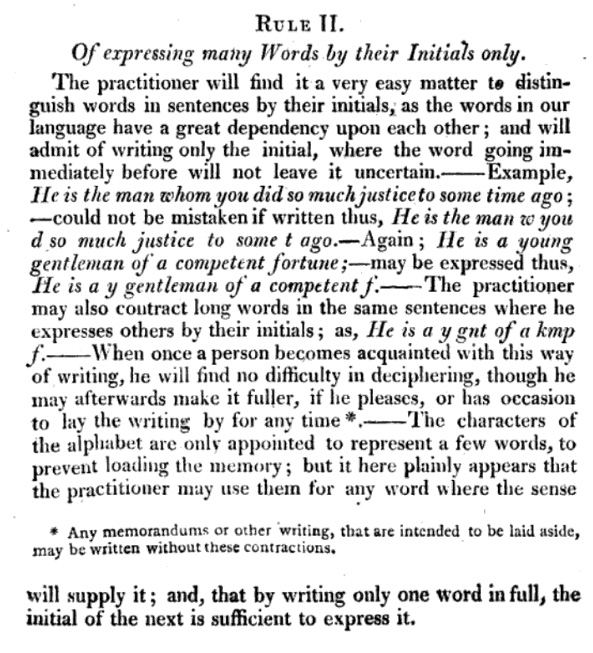
This rule grasps at something fundamental in that many words might be reduced to their initial letter without losing meaning. After all, this is the very definition of an “abbreviation.” There are many outlines in Teeline that use a single letter of the alphabet. For example, the (full) letter “A” for after.

However, Taylor’s approach was far more aggressive than modern Teeline recommends. While he suggested reducing any word to an initial when context permitted, you would be wise to limit this to a carefully chosen set of the most common words — ones that appear so frequently that single-letter representation creates no ambiguity. The idea isn't to start abbreviating everything to initials, but to simply recognise that many words can be safely reduced.
Feel free to experiment with the broader idea here which can be a lifeline in high-pressure situations, especially when you encounter an unfamiliar word (or words) during a fast dictation. Getting down an initial letter (and then moving on quickly) is a better strategy than getting caught up trying to figure out one entire outline or grouping and missing the next five or six words entirely.
Rule III
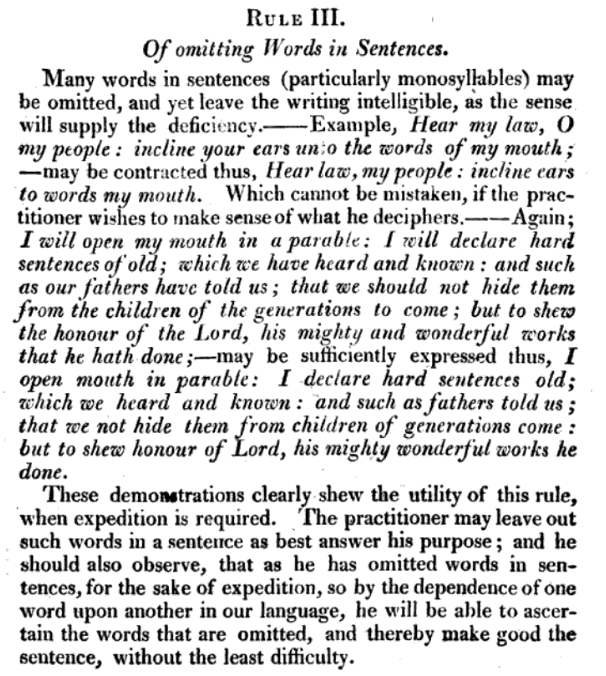
Rule III anticipates modern word groupings where some connecting words disappear. While judgement is always required, Teeline provides many proven word groupings that, once learned properly, won't cause confusion in transcription. Here’s an example where the word “being” is assumed.

Rule IV
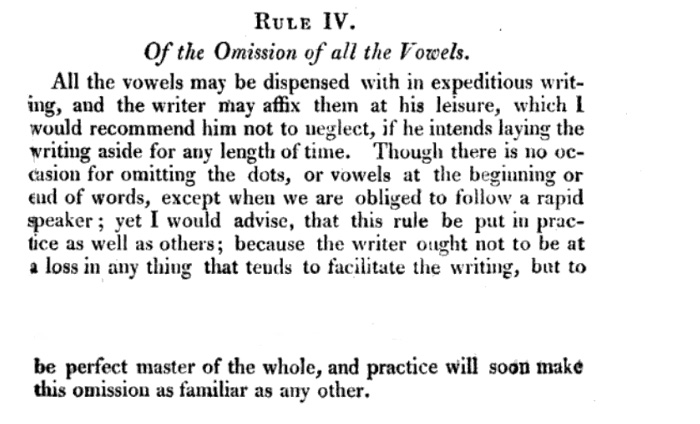
Rule IV discusses what every Teeline student learns — vowels are often redundant. About two-fifths of the longhand characters we write are unnecessary. This means most vowels (A, E, I, O, U) can be eliminated with no loss of comprehension. Refer to the revision section under Beginner’s Lesson One for more information.
Rule V
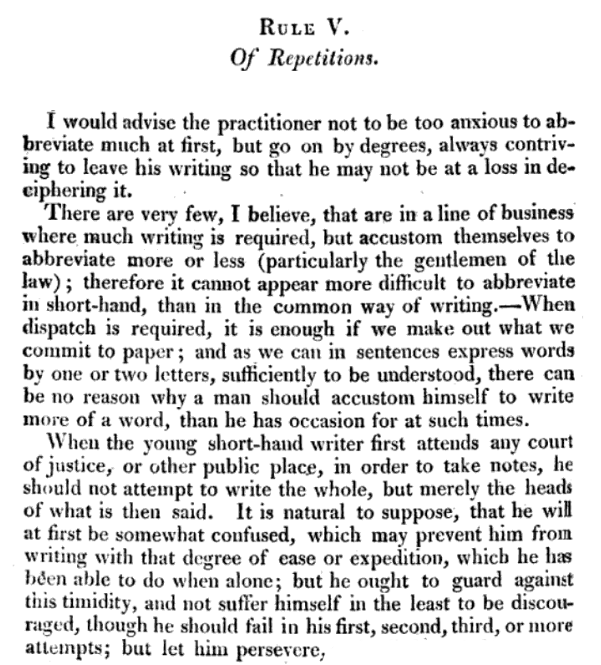
Most valuable for modern students is the recommendation to start conservatively with abbreviations and then become bolder as your confidence grows. This approach to speed building is exactly how Teeline should be learned. Master the basics thoroughly before pushing into advanced techniques.
What is interesting about these historical principles is how they foreshadowed a number of Teeline's innovations. The difference lies in Teeline’s refinement and systematisation. Where early stenographers relied more on individual judgement about abbreviations, Teeline provides tested guidelines.
These “principles of the past” should remind us that efficient writing isn't about learning tricks. Rather, it's about understanding how language actually works and exploiting its natural redundancies.
The best Teeline writers will internalise these insights about contraction, omission, and abbreviation over time, and then apply them creatively within the system's framework.
If you have any questions, please reach out.
Did you see our latest YouTube video?

Teeline Shorthand at 100 WPM | New Flyover brings safety but vigilance is still needed
Jun 29, 2025 - Jo Goodall - Two minutes at 100 WPM.
Be sure to visit us at the LLTT Website, YouTube, Facebook, Instagram, Quizlet and Soundcloud.
If you’re looking for Teeline reading practice, Skill Building Through Reading 📗 - is available for purchase online.
Much work (and ❤️!) has gone into this 48 page, 6x9 softcover book:
Five 5️⃣ carefully selected passages: Improve your sight 👁️ recognition of outlines and word groupings.
Dual Format: Each passage includes both printed Teeline and the longhand ✍️ transcription.
Proven Learning Approach: Reading printed 🖨️ shorthand is a method long-favoured by skilled practitioners.
Whether you're a student, journalist, or professional seeking to improve your note-taking, this book will be a valuable addition to your Teeline learning resources.
To order, please visit the book’s landing page or respond to this email with any questions.
If you find this newsletter helpful, please help us spread the word and forward to a friend!
A Parting Thought
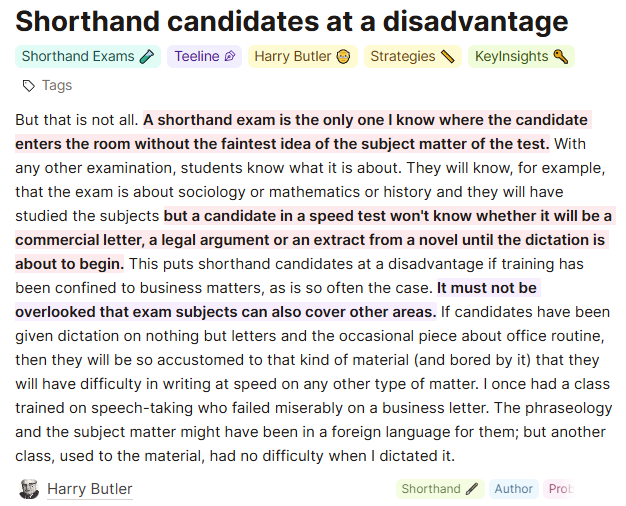

Add a comment: